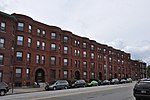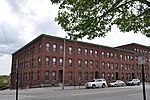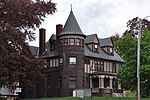District D
Amoskeag Manufacturing CompanyBuildings and structures in Manchester, New HampshireHistoric districts in Hillsborough County, New HampshireHistoric districts on the National Register of Historic Places in New HampshireNRHP infobox with nocat ... and 1 more
National Register of Historic Places in Manchester, New Hampshire

District D is a historic worker housing district located in Manchester, New Hampshire, near the former Amoskeag Manufacturing Company millyard. It is roughly bounded by Canal, Langdon, Elm, and West Brook streets, and was added to the National Register of Historic Places on November 12, 1982. It contains three residential buildings constructed in 1864 in an area of about 3 acres (1 ha).
Excerpt from the Wikipedia article District D (License: CC BY-SA 3.0, Authors, Images).District D
Langdon Street, Manchester
Geographical coordinates (GPS) Address Nearby Places Show on map
Geographical coordinates (GPS)
| Latitude | Longitude |
|---|---|
| N 42.999166666667 ° | E -71.466388888889 ° |
Address
Langdon Street 83
03101 Manchester
New Hampshire, United States
Open on Google Maps







